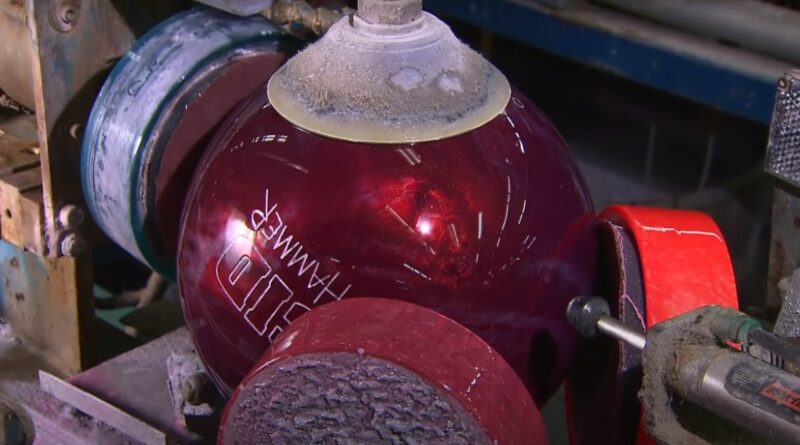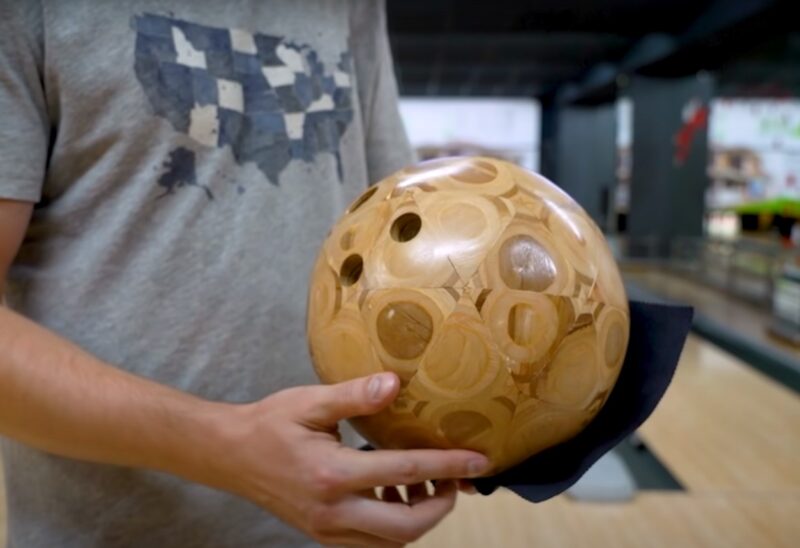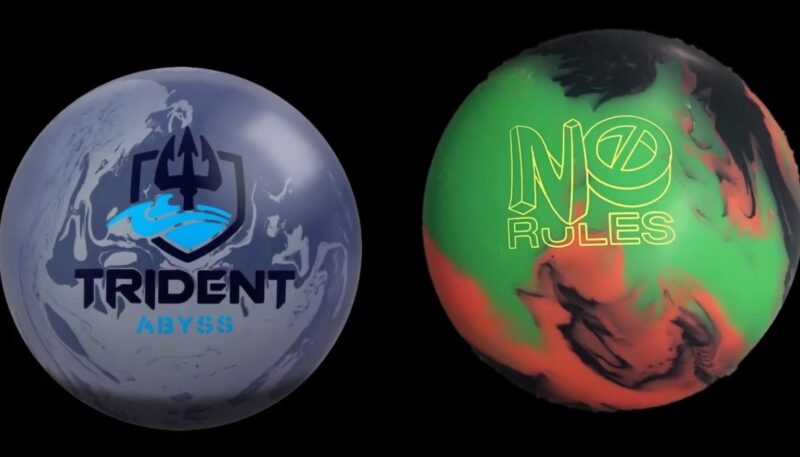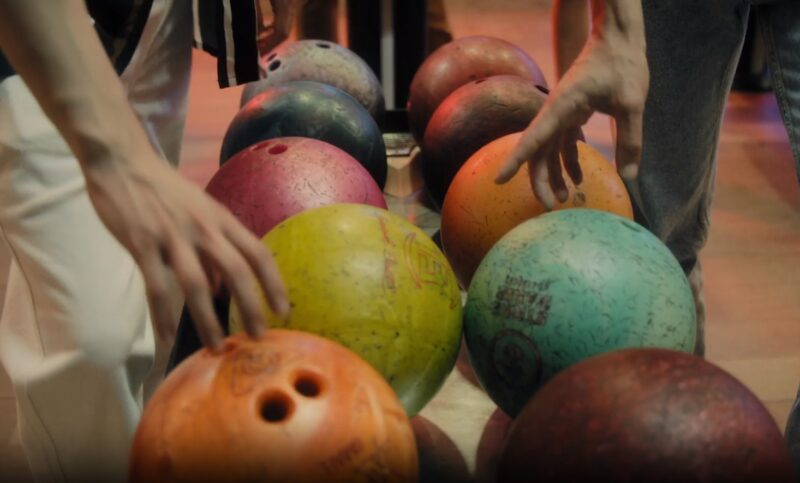Bowling balls have evolved significantly over the years. This evolution, largely driven by advancements in materials science, has led to the creation of diverse types of balls suited for varying levels of play and different styles.
Understanding what bowling balls are made of is not only interesting for those enthusiastic about the sport (like myself), but it also offers insight into how material science impacts sports technology.
The Ball-Making Process

Core and Coverstock
The process of making a modern bowling ball involves constructing a core and adding a coverstock shell. The core, often made from materials like barium, bismuth graphite, or iron oxide, can be designed to create either a ceramic or a plastic-like texture.
Ceramic cores are known for their power, as they do not absorb energy like other materials.
Coverstock Materials
Coverstock, the outer layer of a bowling ball, is crucial in determining its performance. There are three primary materials used:
- Polyester: This is the least expensive material and offers less hook ability. It’s ideal for beginners or those who play casually.
- Urethane: Sitting at a moderate price range, urethane provides more hook ability than polyester but less than resin. It strikes a balance between cost and performance.
- Resin (Reactive Urethane): The most expensive material, resin, offers more durability and hook power, making it a favorite among professional bowlers.
Core Dynamics
The core of a bowling ball plays a pivotal role in its performance. The materials used, such as barium, bismuth graphite, or iron oxide, influence the ball’s weight distribution and balance.
A ceramic core, for instance, is more powerful due to its energy-conserving nature, offering bowlers a more consistent and controlled experience.
Innovation in Coverstock
The evolution of coverstock materials reflects the sport’s technological advancements. Polyester, the most basic and affordable option, is ideal for straight shots due to its minimal hook potential. Urethane, a step up in both price and performance, allows for greater control and a moderate hook.
Resin, the most advanced and costly option, offers the highest degree of durability and hook power, catering to professional players seeking precision and consistency.
Impact of Material Choice
The choice of material not only affects the price but also the playing style and skill level compatibility. Beginners might opt for polyester due to its ease of use and affordability, while professionals might prefer resin for its superior performance characteristics.
Early Materials and Evolution

Initially, bowling balls were crafted from lignum vitae, a hardwood known for its toughness and density. These wooden bowling balls set the foundation for the sport but were limited in terms of durability and consistency. As technology progressed, so did the materials used in bowling ball construction.
In the early 20th century, rubber became the primary material. The introduction of rubber allowed for more uniformity in size and shape, improving the game’s consistency. These rubber balls were known for their durability and were the standard until the late 1950s.
The Introduction of Plastic
The next significant material advancement came with the introduction of polyester, commonly referred to as plastic in the bowling industry. Plastic bowling balls marked a departure from the rubber era, offering improved control and less hook potential.
This made them particularly popular among casual bowlers and those who preferred a straighter bowling style. The manufacturing process of plastic balls involves the pouring of liquid resin into molds, which are then cured to form a hard, durable outer shell.
This technique allowed for more precise control over the weight and balance of the ball, as well as the introduction of vibrant colors and patterns.
Urethane and Reactivity
In the 1980s, urethane bowling balls emerged. Urethane, a more durable and responsive material than plastic, provided bowlers with increased hook potential and greater control on the lanes. These balls are made by combining urethane with various additives, resulting in a material that can grip the lane more effectively.
The introduction of urethane balls revolutionized the sport, as they allowed for more aggressive playing styles and greater versatility in ball movement.
Reactive Resin Era

The 1990s witnessed the introduction of reactive resin balls, a significant advancement in bowling ball technology. Reactive resin, a more advanced form of urethane, includes additives that enhance the ball’s porosity, allowing it to grip the lane even more effectively.
This increased friction between the ball and the lane surface results in a stronger hook and more striking power. Reactive resin balls are typically made by blending different types of materials and chemicals, creating a coverstock with varying degrees of reactivity.
These balls are known for their sensitivity to lane conditions, offering skilled bowlers a higher degree of control and the ability to make more complex shots.
Particle and Hybrid Balls
The late 1990s and early 2000s saw the introduction of particle and hybrid bowling balls. Particle balls, also known as proactive balls, have textured additives in the coverstock, such as glass or ceramic particles, to create more friction and an even stronger hook potential.
Hybrid balls combine the properties of reactive resin and particle balls, offering a balance of control, hook potential, and versatility. These advancements provided bowlers with an array of options, catering to different styles and lane conditions.
FAQs
Can the materials used in bowling balls affect a player’s performance in different lane conditions?
Yes, the material of a bowling ball significantly influences performance in various lane conditions. For example, plastic balls perform well on dry lanes due to their low friction, while reactive resin balls are better suited for oily lanes as they provide more grip and hook potential.
Understanding the interaction between ball materials and lane conditions is crucial for selecting the right ball.
How do environmental factors impact the lifespan of a bowling ball?
Environmental factors like temperature, humidity, and exposure to direct sunlight can affect a bowling ball’s lifespan. Extreme temperatures can cause materials like urethane or reactive resin to expand or contract, potentially leading to cracks.
Keeping the ball at a consistent, moderate temperature and away from direct sunlight can help prolong its life.
Are there any maintenance practices specific to different bowling ball materials?
Yes, different materials require specific maintenance practices. Plastic balls generally need less maintenance and can be cleaned with standard ball cleaners. Urethane and reactive resin balls, however, often require more frequent cleaning to maintain their surface texture and reactivity.
Regular polishing or sanding might also be necessary depending on the desired lane traction.
Do the materials used in bowling balls have an expiration date or lose effectiveness over time?
Bowling balls don’t have an official expiration date, but their effectiveness can diminish over time, especially with frequent use. Factors like the absorption of oil, surface wear, and internal stress can affect a ball’s performance.
Reactive resin balls, in particular, tend to absorb oil over time, which can reduce their reactivity and hook potential.
Is there a significant weight difference between bowling balls made of different materials?
The weight of a bowling ball is largely standardized across different materials, usually ranging from 6 to 16 pounds. However, the distribution of weight can vary depending on the material and core design.
For instance, balls with denser core materials like bismuth or tungsten might feel heavier at the center, affecting the ball’s balance and movement.
Can a bowler use any type of bowling ball in professional tournaments, or are there restrictions based on materials?
Professional tournaments often have specific rules regarding the types of bowling balls allowed. These rules can include restrictions on the materials of the coverstock, the hardness of the ball, and the properties of the core.
Bowlers must ensure their equipment complies with the regulations of the tournament or bowling league they are participating in.
Summary
The materials used in bowling ball construction have evolved significantly, moving from wood and rubber to advanced polymers and composites. This evolution reflects broader trends in materials science and manufacturing technology.
Today’s bowling balls are sophisticated pieces of sporting equipment, offering a range of features and capabilities to suit various playing styles and preferences.
As technology continues to advance, it is likely that bowling balls will see further innovations, enhancing the sport’s appeal and the experience of bowlers around the world.
